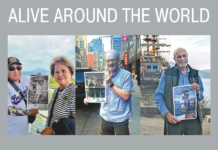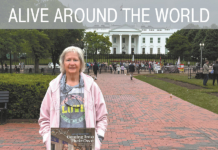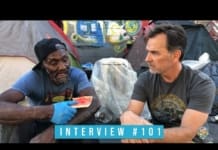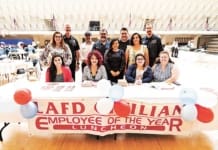 Send in your ALIVE! AROUND THE WORLD
Send in your ALIVE! AROUND THE WORLD
Take Alive! with you wherever you go! Bring your recent copy of Alive! with you when you travel and snap a high resolution photo of you holding Alive! Send in your pictures and text (click on the button to go to the form), and we’ll publish it.
SUBMIT YOUR ALIVE! AROUND THE WORLD
![]()
Letter From Barbados, Part 1
Capt. Michael Barnes, Retired, Harbor, reports from the Caribbean.

Barbados, known as the Little Britain of the Caribbean, is situated northeast of mainland South America. An area of about 167 square miles, it features stunning sandy beaches, turquoise waters, sunshine, rum and the friendliest people of all the Caribbean islands.
Bridgetown, the capital, originally named St. Michael, before it was renamed for the 1673 Garrison Commander Colonel Sir Tobias Bridge. Once upon a time there were indigenous people living here, but they had abandoned the island by the time the first Spanish and Portuguese merchant ships dropped anchor on their way to Brazil in 1511.
A Portuguese explorer, Pedro a Campos, named the island Los Barbados (bearded-ones) presumably after the island’s large fig trees that resemble a beard-like appearance. Campos introduced pigs to the island to supply meat for future travelers coming to the island.
Pedro a Campos did not stay on the island. English privateer Capt. John Powell arrived on the good ship Olive Blossom in 1625. Upon his arrival, Capt. Powell planted the British flag and claimed the island for King James I.
Two years later, his brother, Capt. Henry Powell, landed with a party of 80 permanent settlers and 10 slaves who were captured at sea and brought to Barbados to occupy and settle the island. This expedition landed in Holetown, formerly known as Jamestown, and within a few years much of the land had been deforested to make way for tobacco and cotton plantations.
As the Roman Catholic church continued expanding the Inquisition operation into Brazil, many Jewish merchants and plantation owners fled the country seeking safety with the English on the island of Barbados, bringing with them the first sugar cane plants. The rest is history.
In 1660, cultivating sugar cane occupied about 60 percent of the island’s land and accounted for a whopping 90 percent of its total exports. The British Navy’s tradition of a daily issue of rum to all its sailors accounted for some of that converted sugar wealth. However, on July 31, 1970, now known as Black Tot Day, British sailors had their last daily tot ration. Many wore black armbands and poured their ration into the sea as a symbolic “burial” of the much-loved tradition.
On Nov. 30, 1966, Barbados became an independent state and in 2021 a republic within the Commonwealth of Nations.
In all our travels, we have never met a more friendly and hospitable people. Exploring the island by public bus or smaller mini-buses, the price was the same, no matter what distance we were traveling. Bus stops around the island are very casual; we simply flagged down any passing bus, and if there was space, would squeeze in.
We visited the Four-Square Rum Factory, a bit off the beaten track but well worth the effort and the walk. There is no entrance fee and it is unlike the rum distilleries in town — guests are able to wander around to discover lots of interesting things. The tasting room is really cool. The place does not serve food, but a food truck comes at noon for the local workers, so if you have an adventurous palate, enjoy some real local food in the distilleries garden.
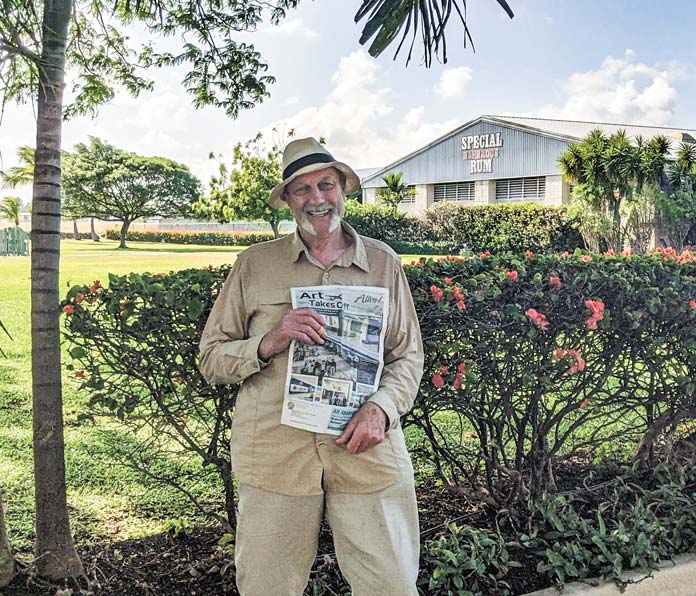
Barbados enjoys seven golfing clubs, where you can even do like Tiger Woods and get married between holes at the Sandy Lane course. For those who like deep sea and game fishing, the waters off the coast of Barbados and neighboring islands Grenada, Tobago and St. Lucia are perfect.
For a more leisurely way to view of the local fish, take a Catamaran ride out to Carlisle Bay to snorkel or dive to see one of six shipwrecks. The 70-foot French tugboat Berwyn sits between seven and 10 feet below the surface (depending on the tide) and has lots of marine life, making it a great sight for photography. It is rumored that the crew deliberately scuttled her in 1916 to avoid the WWI marine conflict, and just opened her seacocks and let her slowly sink (which is why she is essentially upright today, though she’s deteriorating fast). All on board including the ship’s cat swam ashore to Browne’s Beach, unharmed.

For cruise ship visitors who have only a short time on the island, do visit Mount Gay Visitor Centre and Distilleries. It’s not cheap, but it’s convenient. If you have more time, enjoy a day tour to explore Harrison’s underground cave. Stroll the palm-lined beach of Bathsheba renowned for its surf, check out the Green Monkeys at the Barbados Wildlife Reserve, take a stroll through lush rainforest at the Hunt’s Gardens, or explore the Flower Forest, teeming with tropical plants and flowers. Our favorite is the little steam train ride at the 17th-century sugar plantation of St. Nicholas Abbey up to the top of Cherry Hill, from where there is a great view of the island beaches.
For history buffs there is the Old British Garrison and grounds to explore, with its collection of canons and museums. There is also a house where George Washington was supposed to have stayed in as a young man, before he joined the British army the following year as an officer.
Sports fans will not be disappointed as there is an impressive horse race track and cricket venue called the Oval, home to the world largest bat and ball. (Cricket is like baseball but slower.)
There are more than 100 religious groups on Barbados, and their places of worship range from the majestic coral stone structures to the simple chattel house: Anglican, Roman Catholic, Apostolic Teaching Centre, Buddhist are represented, and there is also a Synagogue considered one of the oldest synagogues in the Western Hemisphere, complete with a mikvah.
As for the nightlife, check the Gap in St. Lawrence for loud music and fish market at Oistin’s for inexpensive indigenous food.
We traveled to Barbados on JetBlue via Miami — lots of legroom, and JetBlue is the last airline to have seatback screens. The downside: if you fly cheap, carry-on is extra.
Remember: “Twenty years from now you will be more disappointed by the things that you didn’t do than by the ones you did do.”
Cheers!
— Capt. Michael Barnes



